|
|
 |
|
Calanoida ( Order ) |
|
|
|
Clausocalanoidea ( Superfamily ) |
|
|
|
Aetideidae ( Family ) |
|
|
|
Pseudeuchaeta ( Genus ) |
|
|
| |
Pseudeuchaeta brevicauda Sars, 1905 (F,M) | |
| | | | | | | Syn.: | Autanepsius minor Wolfenden, 1906 (p.41, Descr.F, figs.F); 1911 (p.352, figs.F) | | | | Ref.: | | | Sars, 1905 b (p.18, Descr.F); Farran, 1908 b (p.31, Rem.); Sars, 1925 (p.102, figs.F); Rose, 1933 a (p.124, fig.F); Jespersen, 1934 (p.69); Lysholm & al., 1945 (p.21); Sewell, 1947 (p.106, figs.F); Vervoort, 1952 h (n°49, p.3, figs.F); 1957 (p.69, Rem.); 1963 b (p.155); Paiva, 1963 (p.41, Rem.); Owre & Foyo, 1967 (p.50, figs.F); Tanaka & Omori, 1970 b (p.146, figs.F,M, Rem.); Park, 1978 (p.187, figs.F, Rem.); Bradford & Jillett, 1980 (p.64, figs.F,M, distribution chart); Markhaseva, 1986 b (p.1895); 1996 (p.241, figs.F,M); Chihara & Murano, 1997 (p.688, Pl.26,28: F,M); Markhaseva & Schulz, 2006 a (p.152); Vives & Shmeleva, 2007 (p.594, figs.F,M, Rem.) | 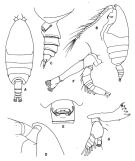 issued from : T. Park in Antarctic Res. Ser. Washington, 1978, 27. [p.188, Fig.57]. Female: A, habitus (dorsal view); B, idem (lateral); C, posterior part of metasome and urosome (lateral); D, forehead (lateral); E, genital segment (ventral); F, A2; G, Md.
|
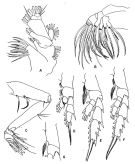 issued from : T. Park in Antarctic Res. Ser. Washington, 1978, 27. [p.189, Fig.58]. Female: A, Mx1; B, Mx2; C, Mxp; D, P1; E, P2; F, P3; G, basipod of P4 (anterior). P1-3: legs (anterior).
|
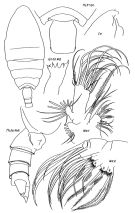 issued from : E.L. Markhaseva in Proc. Zool. Inst. RAN, St. Petersburg, 1996, 268. [p.245, Fig.194]. Female (from NW Pacif.: Kuril Trench). Ce: forehead (lateral); Gntb Md: gnathobase of Md (partial).
|
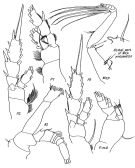 issued from : E.L. Markhaseva in Proc. Zool. Inst. RAN, St. Petersburg, 1996, 268. [p.246, Fig.195]. Female (from NW Pacif.: Kuril Trench). P.md: mandibular palp.
|
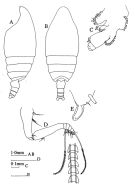 issued from : J.M. Bradford & J.B. Jillett in Mem. N.Z. oceanogr. Inst., 86, 1980. [p.65, Fig.43]. Female: A, habitus (lateral left side); B, idem (dorsal); C, Mx1; D, Mxp; E, distal part of basipod 1 of Mxp. Nota: The specimen from the New Zealand does not appear to differ from the Sewell's (1947) specimen.
|
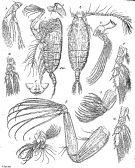 Issued from : G.O. Sars in Résult. Camp. Scient. Prince Albert I, 69, pls.1-127 (1924). [Pl.XXIX, figs.1-12]. Female: 1, habitus (lateral left side); 2, idem (dorsal); 3, forehead (lateral); 4, A2; 5, labrum ventral view); 6, Md; 7, Mx1; 8, Mx2; 9, Mxp; 10, P1; 11, P2; 12, P4.
|
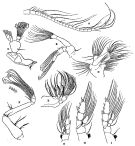 issued from : R.B.S. Sewell in The John Murray Expedition, 1933-34, Scientific Reports, VIII (1), 1947. [p.107, Fig.22]. As Pseudochirella brevicauda (lapsus calami). Female (from N Arabian Sea): A, A1; B, A2; C, Md; D, Mx1; E, Mx2; F, Mxp; G, P1; H, P2; I, P3. Nota: The proportional lengths of the various segments of the body (cephalon to caudal rami) as 402:118:94:67:57:27:94:47:37:27 = 1000. Head and 1st pediger segment separate, 4th and 5th fused. A1 24-segmented (segments 8-9 fused) reaches back to about the end of cephalothorax. In A2 the two branches are approximately equal length; outer ramus 7-segmented, of these the 1st is produced on its anterior margin ib two small prominences, from each of which arises a small seta, and the 2 nd segment also carries one such projection near the proximal end. In Md the 2nd basal segment bears 1 seta. In Mx1 the various lobes bear : 1st inner lobe (13 setae), 2nd (4), 3rd (3); 2nd basal segment (5); 1st segment endopod (4), 2nd (4), 3rd (6); exopod (10); outer lobe (8 setae). In Mx2 the 5th lobe is considerably longer than the others, the 2nd, 3rd and 4 th lobes are fringed with fine spines, each lobe bears 3 setae.
|
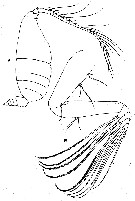 issued from : R.N. Wolfenden in Die Marinen Copepoden der Deutschen Südpolar-Expedition 1901-1903, 1911. [Pl.XXXVIII, Figs.9-10]. As Autanepsius minor. Female: 9, habitus (lateral); 10, Mxp.
|
 issued from : O. Tanaka & M. Omori in Publ. Seto mar. Biol. Lab., 1970, XVIII, 3. [p.147, Fig.12]. Female (from Izu Region, Japan): a-b, forehead (dorsal and lateral, respectively); c-d, last thoracic segment and urosome (dorsal and left lateral, respectively); e, genital segment (ventral); f, Md (cutting blade); g, Mx1; h, Mx2; i, P1; j, P2; k, endopod of P4; l, head (lateral); m, A2; n, Mx1; o, P1. a-k: body length 5.55 mm. l-o: another female (6.40 mm length). Nota : Cephalothorax and urosome in the proportional lengths 77 :23. Head and 1st thoracic segment fused, 4th and 5th segments partially fused. Lateral distal margin of the last thoracic segment obtusely pointed. Rostrum as a small knob. Urosomal segments and caudal rami in the proportional lengths 44 :18 :14 :8 :16 = 100. Caudal rami about as long as wide. A1 24-segmented (segments 8-9 fused), extends to the 4th thoracic segment. A2 endopod 1.2 times as long as exopod, exopod 7-segmented.Mx1 : 8 setae on the outer lobe, 11 setae on the exopod, 6+4+4 setae on the 3rd to 1st segments of the endopod, 5 setae on the 2nd basal segment, 3 setae on the 3rd inner lobe, 4 setae on the 2nd inner lobe, and 13 setae on the 1st inner lobe ; endopod large and strong ; strong setae on the endopod and 2nd basal segment. Mx2 : 1st to 5th lobes each carry 3 setae ; endopod with 6 setae. ; Another specimen (measuring 6.40 mm) much larger than the others, shows several structural differences : A1 reaches the end of the 3rd thoracic segment ; rostrum represented by a blunt knob (much larger than that of the other specimens) ; In Mx1, 3rd to 1st segments of endopod with 4+4+4 setae ; 2nd basal segment bears 4 setae ; in P1 the outer marginal spine on the 2nd segment of exopod is large, extending nearly to the distal margin of the 3rd exopodal segment ; the exopod bears no hairs on the outer margin. the terminal spine of exopod of P2 bears 41 teeth.
|
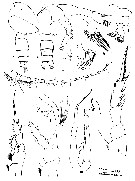 issued from : O. Tanaka & M. Omori in Publ. Seto mar. Biol. Lab., 1970, XVIII, 3. [p.148, Fig.13]. Male: a, forehead (lateral); b, last thoracic segment and urosome (lateral); c, urosome (dorsal); d, A1; e, A2; f, Md; g, Mx1; h, Mx2; i, Mxp; j, P1; k, exopod of P2; l, endopod of P3; m, P5. Nota : cephalothorax and urosome in the proportional lengths 79 :21. Head and 1st thoracic segment separated, 4th and 5th fused. . Rostrum represented by a small knob. Urosome 5-segmented, proportional legths (with the caudal rami) 17 :38 :17 :12 :2 :14 = 100. ; 2nd to 4th segments fringed with spinules on the distal margin. Left . A1 23 segmented (segments 8-9 and 20-21 fused, respectively), reaches the end of the 3rd thoracic segment. A2 endopod slightly longer than the endopod ; 2nd exopodal segment with a small prominence on the proximal margin ; endopod with 6 setae on the outer lobe. Md : exopod with 6 setae, endopod with 9 setae, cutting blade reduced much, with 3 teeth. Mx1 : 11 setae on the exopod, 4+1+3 setae on the 3rd to 1st segments of the exopod, 4setae on the 2nd basal segment, 1 seta on the 3rd inner lobe, no setae on the 2nd inner lobe, and 1 minute seta on the 1st inner lobe. Mx2 well-developed, 1st to 6th lobes have 2, 3, 3, 3, 3 and 1 setae respectively ; endopod with 5 setae.Mxp : 1st and 2nd basal segments about equal in length, the distal seta on the 1st basal segment is transformed into a process notched at the apex.
|
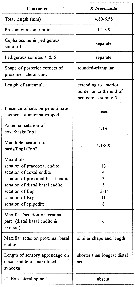 issued from : E.L. Markhaseva & K. Schulz in Invert. Zool., 2006, 3 (2). [p.152, Table 2]. Selected character for Pseudeuchaeta brevicauda female.
|
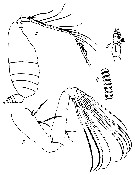 issued from : R.N. Wolfenden inPlankton Studies, Part II, 1906. [Pl. XIII, 2-5]. As Autanepsius minor.
Female: 2, habitus (lateral); 3, Mxp; 4, cups-like on distal half of 9 bristles of Mxp; 5, Md (mandibular palp).
|
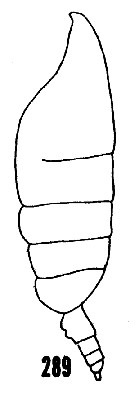 issued from : H.B. Owre & M. Foyo in Fauna Caribaea, 1, Crustacea, 1: Copepoda. Copepods of the Florida Current. [p.49, Fig.289]. Female (from 15°00'N, 67°05'W): 289, habitus (lateral).
|
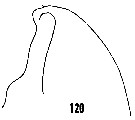 issued from : H.B. Owre & M. Foyo in Fauna Caribaea, 1, Crustacea, 1: Copepoda. Copepods of the Florida Current. [p.26, Fig.120]. Female: 120, forehead (lateral).
|
 issued from : H.B. Owre & M. Foyo in Fauna Caribaea, 1, Crustacea, 1: Copepoda. Copepods of the Florida Current. [p.26, Fig.127]. Female: Mxp.
|
 Pseudeuchaeta brevicauda Pseudeuchaeta brevicauda female: 1 - Posterior corners of last thoracic segment not prolonged into points, but triangularly, sometimes with slight knob on top . 2 - Exopodal segment 1 of P1 without external spine.
|
 Pseudeuchaeta brevicauda Pseudeuchaeta brevicauda male: 1 - Exopodal segment 3 of left P5 with small terminal spine.
| | | | | Compl. Ref.: | | | C.B. Wilson, 1950 (p.316); Grice, 1963 a (p.495); Grice & Hulsemann, 1965 (p.223); 1967 (p.15); 1968 (tab.2); Björnberg, 1973 (p.325, 389); Deevey & Brooks, 1977 (p.256, tab.2, Station "S"); Vives, 1982 (p.291, as Pseudoeuchaeta); Razouls & al., 2000 (p.343, Appendix); Holmes, 2001 (p.50); Park & Ferrari, 2009 (p.143, Table 4, Appendix 1) | | | | NZ: | 14 | | |
|
Distribution map of Pseudeuchaeta brevicauda by geographical zones
|
| | | | | | | | |  Issued from : E.L. Markhaseva, I. Mohrbeck & J. Renz in Mar. Biodiv., 2017, 47. [p.295, Fig.7] Issued from : E.L. Markhaseva, I. Mohrbeck & J. Renz in Mar. Biodiv., 2017, 47. [p.295, Fig.7]
Distributional range of Pseudeuchaeta brevicauda Sars, 1905 (for refetences of literature sources compiled, see Markhaseva, 1986, 1996). |
| | | | Loc: | | | Antarct. (Indian, SE Pacif.), sub-Antarct. (SE Pacif.), G. of Guinea, Cape Verde Is., off Morocco-Mauritania, Canary Is., off Madeira, Azores, Caribbean Sea, Sargasso Sea, off Bermuda: Station "S" (32°10'N, 64°30'W), S Davis Strait, off W Ireland, W Gibraltar, off Bay of Biscay, Arabian Sea, Indian, Japan (Izu), Mariana Rrench, New Zealand, Kuril-Kamchatka, NE Pacif., off Galapagos, off Peru, off Is. Juan Fernandez Is., Chile (N & S) | | | | N: | 26 | | | | Lg.: | | | (1) F: 5,2; (10) F: 4,8; (11) F: 4,8; (14) F: 5,43-5; (20) F: 6,58; (25) F: 5,9; (37) F: 6,58-4,8; M: 5,9; (73) F: 5,56; (112) F: 6,4; 5,55; M: 5,9; (201) F: 6; (238) F: 4,8; {F: 4,80-6,58; M: 5,90} | | | | Rem.: | bathy-abyssopelagic.
Sampling depth (Antarct. sub-Antarct.): 1000-2000 m. Sargasso Sea: 500-2000 m (Deevey & Brooks, 1977, station "S") | | | Last update : 28/12/2017 | |
|
|
 Any use of this site for a publication will be mentioned with the following reference : Any use of this site for a publication will be mentioned with the following reference :
Razouls C., Desreumaux N., Kouwenberg J. and de Bovée F., 2005-2025. - Biodiversity of Marine Planktonic Copepods (morphology, geographical distribution and biological data). Sorbonne University, CNRS. Available at http://copepodes.obs-banyuls.fr/en [Accessed November 28, 2025] © copyright 2005-2025 Sorbonne University, CNRS
|
|
 |
 |



















